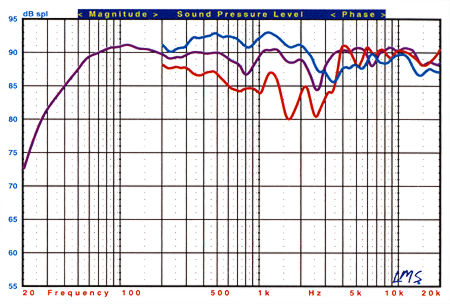PSB Image surround speaker system Measurements
The PSB Image T65's sensitivity measured approximately 90dB/W/m. Its ported cabinet is tuned to about 32Hz, and its minimum impedance measured 4.2ohms at that frequency; I would rate its nominal impedance at 6ohms. The speaker should be relatively easy to drive.

Fig.1: PSB Image T65, pseudo-anechoic horizontal response at 45 (red) and 60 (blue) relative to tweeter axis.
The pseudo-anechoic response of the T65 at tweeter height, averaged over a 30° forward horizontal angle and combined with the nearfield responses of the woofer and port, is shown in Fig.1 (violet). The useful bass extends down to about 29Hz (–10dB relative to the output at 100Hz). The general trend of the on-axis average is quite flat, with no serious peaks, but prominent dips at 800Hz and 2.5kHz. (Dips are generally less audible than peaks of equivalent size.) The response becomes a bit rougher as you move well off the horizontal axis, with a prominent rise centered in the 5kHz region, followed by the high-frequency rolloff typical of most tweeters.

Fig.2: PSB Image T65, pseudo-anechoic vertical response at +15 (red) and –15 (blue) relative to tweeter axis.
Fig.2 again shows the T65's averaged horizontal front response (violet), plus the vertical responses taken at +15° (red) and –15° (blue) relative to the tweeter. The best response is on the tweeter axis, with a seated ear height below that axis preferable to one above. This is clearly a speaker you should audition while seated.
The Image C60 center-channel's cabinet is tuned to about 50Hz. I would rate its nominal impedance at 15ohms. The impedance remains above 10ohms through most of the bass and midrange, dropping to a minimum value of 6ohms at 5kHz. Its high impedance should make the C60 a very easy load to drive, though this will limit the amplifier power available. (The power output of a typical solid-state amplifier generally drops by half with each doubling of the load impedance.) The speaker's sensitivity measured about 88dB/W/m.
The C60's measured front horizontal response, taken on the tweeter axis and averaged in the same manner as described above for the T65, is shown in Fig.3 (violet). The useful bass extension is approximately 45Hz (–10dB relative to the output at 100Hz). The on-axis response is not as smooth as the T65's; a noticeable suckout centered at about 2.5kHz, very near the ear's most sensitive region, could result in a slightly laid-back sound. Indeed, Scott's comment about dialog intelligibility could relate, at least partially, to this laid-back center-channel response.

Fig.3: PSB Image C60, pseudo-anechoic horizontal response at 45 (red) and 60 (blue) to left of tweeter axis.
As the listener moves horizontally off-axis, the C60 develops the response irregularities typical of center-channel speakers with horizontally arrayed drivers. These are clearly visible in Fig.3.
The C60's vertical off-axis response (not shown) follows the on-axis response very closely across the entire range. The small deviations it does exhibit favor the below-axis location, though the response changes should not be audible within the +/-15° mea-surement window.
The horizontal off-axis performance of the C60 should be carefully considered in relation to the physical layout of your system. For serious listening at a normal distance, I recommend a seating area no wider than a typical sofa—prominent response deviations in the speaker's response begin to occur as you move more than 15° off the lateral axis. Scott Wilkinson's seating location is well within this 15° angle.
Apart from that, this is a good set of measurements for what, in today's market, is a modestly priced speaker package.—Thomas J. Norton
All figures: Violet: Pseudo-anechoic response on tweeter axis, averaged across a 30° horizontal window, combined with nearfield response of woofers and port.
- Log in or register to post comments


























































